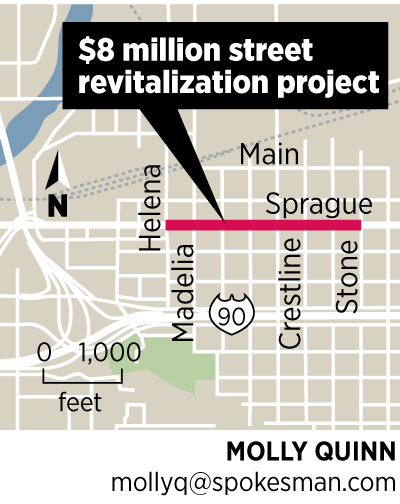East Sprague Avenue upgrades postponed to 2017

Complex design work for East Sprague Avenue street and walkway improvements is forcing a delay in construction until next year.
Spokane officials said the earliest construction on the $8 million project could begin in October, but that would leave the project uncompleted next winter.
The plan calls for rebuilding East Sprague with new pavement, pedestrian amenities and infrastructure improvements through the heart of the neighborhood business district from Helena to Stone streets.
The greatest number of improvements would be concentrated in the blocks from Madelia to Crestline streets, said Marlene Feist, city spokeswoman.
Business owners in the neighborhood said they did not want Sprague to undergo construction starting this fall because it could not be completed until 2017.
That would leave partially completed work lying dormant next winter.
Tara Brown, president of the East Spokane Business Association, said her group supports the delay.
“We’d all like to see it as soon as we can, but we all want it to be done right,” she said.
The city is designing the project with city staff.
Brown said her group doesn’t want to see the project rushed, especially design work.
Funding is coming from a variety of sources: the city street levy for street reconstruction, utility funds for stormwater work and state grants.
Sprague already has been converted to a three-lane street with one through lane in each direction and a center turn lane.
Curbs would be extended at intersections to shorten pedestrian crossing distances.
Street furniture, lighting, green areas and stormwater collection methods will be installed. Pavement that allows stormwater to soak into the ground may be used in parking areas, Feist said.
The Spokane Transit Authority has identified East Sprague as one of its busier lines that could be improved with high-performance features.
But STA would prefer to load and unload passengers without pulling out of traffic to keep buses moving quickly, Feist said.
That has drawn opposition from business owners, who fear that it will cause problems by delaying traffic.
Also, eliminating curbside bus stops will maximize parking spaces in an area that relies on street parking for customers and clients, Feist said.
The project from Helena to Stone is the first of two major street redevelopments on East Sprague.
Phase two would upgrade Sprague from Division to Sherman streets at the end side of a new pedestrian and bicycle bridge that is being built over the BNSF Railway main line to connect the Sprague business area with the University District campus.
The two projects are seen as key to economic revitalization in the area, officials said.
Brown said business and property owners hope East Sprague will enter a new growth cycle that will be similar to urban revitalization that’s become common in U.S. cities.
In a separate move to bolster revitalization, property and business owners are banding together to form a business improvement district in the vicinity of the improvements in the first phases of work.
Owners would contribute assessments to the district with the money going for lighting, security, signage, furniture, planters, cleanup, maintenance and other needs.
The assessments run from a minimum of $50 a year to a maximum of $1,000 a year and are based on property tax values and square footage.
Brown said the idea is to create a continuous source of funding to support the neighborhood as a business district.
Spokane City Council members are expected to consider approval of the business improvement district in the coming month.
An ordinance creating the district is scheduled for adoption April 18, Brown said.
Some of the strategies developed for the neighborhood stem in part from consultant work and a workshop put on by Smart Growth America.
The business association also has teamed up with organizations including East Central Community Organization, Eastern Washington University and Spokane Community Colleges.
The business association website said the group is working “to develop solid business plans and to create a unique streetscape and walkable streets based on the Main Street model.”
The Main Street model is an approach to revitalization that emphasizes historic preservation and employs existing assets such as historic buildings, cultural resources and local businesses.
East Sprague is rich in the diversity of its assets and history, Brown said.
Brown said all of the different efforts along Sprague “are coming to fruition.”
“People should come see the neighborhood,” she said.